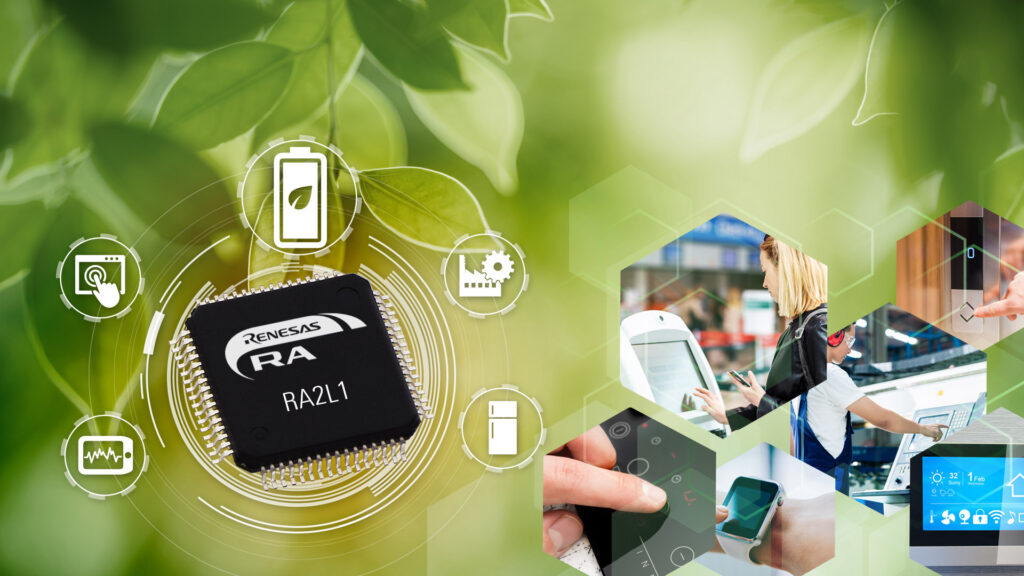 Renesas Electronics Corporation announced the expansion of its 32-bit RA2 Series microcontrollers (MCUs) with 20 new RA2L1 Group MCUs, increasing the RA Family to 66 MCUs. The general-purpose RA2L1 MCUs use the Arm Cortex-M23 core operating up to 48 MHz. The RA2L1 MCUs are supported by the easy-to-use Flexible Software Package (FSP) and Renesas’ partner ecosystem, which offers software and hardware building block solutions that work out-of-the-box. The ultra-low power and innovative touch interface of the RA2L1 MCUs make them ideal for home appliances, industrial and building automation, medical and healthcare, and consumer human-machine-interface (HMI) IoT applications.
Renesas Electronics Corporation announced the expansion of its 32-bit RA2 Series microcontrollers (MCUs) with 20 new RA2L1 Group MCUs, increasing the RA Family to 66 MCUs. The general-purpose RA2L1 MCUs use the Arm Cortex-M23 core operating up to 48 MHz. The RA2L1 MCUs are supported by the easy-to-use Flexible Software Package (FSP) and Renesas’ partner ecosystem, which offers software and hardware building block solutions that work out-of-the-box. The ultra-low power and innovative touch interface of the RA2L1 MCUs make them ideal for home appliances, industrial and building automation, medical and healthcare, and consumer human-machine-interface (HMI) IoT applications.
The RA2L1 MCUs are designed for ultra-low power consumption, with several integrated features to lower BOM costs, including capacitive touch sensing, embedded flash memory densities up to 256 KB, SRAM at 32 KB, analog, communications, and timing peripherals, and safety and security functions. In many battery-powered applications, the MCU spends most of the time in a low-power standby mode waiting for an internal or external event to wake-up the CPU and process data, make decisions, and communicate with other system components.
When benchmarked for power consumption, the RA2L1 MCU was certified with an EEMBC ULPMark score of 304 at 1.8V, verifying its best-in-class power rating. Users can now minimize power consumption close to the standby levels to extend battery life.
The advanced capacitive touch IP in the RA2L1 MCUs provides enhanced operability for a variety of touch and touchless system implementations. For example, it supports sensing through acrylic or glass panels more than 10 mm thick, which is enough for use in household equipment with thick doors or partitions. It also implements proximity sensing (hovering) and 3D gestures. This accommodates hygiene or safety limitations. The RA2L1’s capacitive touch noise tolerance meets the requirements of IEC EN61000-4-3 level 4 (radiated) and EN61000-4-6 level 3 (conducted) to assure reliable operation with minimal sensing errors.
Key Features of the RA2L1 MCU Group include: 48 MHz Arm Cortex-M23 CPU core; Support for wide operating voltage range: 1.6V – 5.5V; Ultra-low power consumption delivering an operating current of 64 μA/MHz and software standby current of 250 nA with less than 5 µs fast wakeup; Employs Renesas’ 110nm low-power process for active and sleep/standby modes and special power-down modes designed for battery-driven applications; Flexible power modes achieve lower average power for multiple applications; Integrated next-generation innovative capacitive touch sensing unit with no external components required, lowering BOM costs; Enables system costs reduction with on-chip peripheral functions, including a high precision (1.0%) high-speed oscillator, temperature sensor, and multiple power supply interface ports; Background operation data flash supporting 1 million erase/program cycles; Scalable from 48-pin to 100-pin LQFP packages
The RA2L1 MCUs also offer an IEC60730 self-test library and feature integrated safety functions that provide confirmation of normal operation. Customers can easily use these safety functions to perform MCU self-diagnostics. In addition, the RA2L1 includes an AES cryptography accelerator, a true random number generator (TRNG), and memory protection units that provide the fundamental blocks to develop a secure IoT system.
The RA2L1 MCUs with Flexible Software Package (FSP) allows customers to re-use their legacy code and combine it with software from partners across the vast Arm ecosystem to speed implementation of complex connectivity and security functions. The FSP includes FreeRTOS and middleware, offering a premium device-to-cloud option for developers. These out-of-box options can be easily replaced and expanded with any other RTOS or middleware.
The FSP also includes a best-in-class HAL driver, as part of the FSP, and provides a host of efficiency-enhancing tools for developing projects targeting the RA2L1 MCUs. The e2 studio Integrated Development Environment provides a familiar development cockpit from which the key steps of project creation, module selection and configuration, code development, code generation, and debugging are all managed. The FSP uses a GUI to simplify the process and dramatically accelerate the development process, while also making it easy for customers to transition from an original 8/16-bit MCU design.
The RA2L1 MCUs are available now from Renesas’ worldwide distributors.





Leave a Reply